-
Engine4.8L Twin-Turbo V8
-
Power550 HP / 590 LB-FT
-
Transmission7-Speed PDK
-
0-60 Time3.5 Seconds
-
Top Speed190 MPH
-
DrivetrainAll-Wheel Drive
-
Curb Weight4,398 LBS
-
Seating2+2
-
MPG15 City / 23 HWY
So others are aware of the Panamera's potential, Porsche reserves its coveted 'Turbo' script only for its most capable vehicles. It is indeed a badge of honor. However, the ante is upped even further when a small scripted 'S' is adhered as a suffix. Its addition indicates to all others that the overall performance has been boosted to flagship levels – it is a tiny yet bold badge of bravado.
To help us solve the riddle of whether or not the Panamera Turbo S is more than just an exercise in demonstrating masculine superiority within ones social circle, Porsche deposited a stunning Aqua Blue Metallic example in our driveway for a week. It was our job to put the $195,000, four-passenger neck-snapper to the test and somehow avoid filling its glovebox with citations in the process.
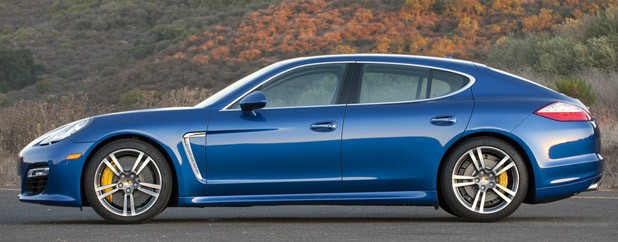
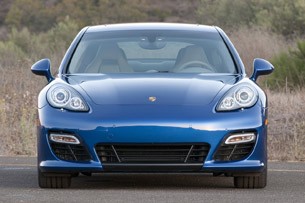
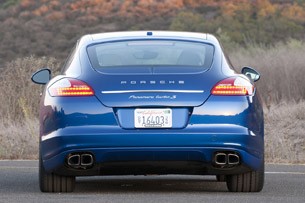
Our first introduction to the Porsche Panamera, the automaker's first four-door car after nearly 78 years of manufacturing passenger vehicles, was in Germany during the summer of 2009. Our initial impressions were that Porsche had delivered a fine piece of machinery hidden beneath some controversial sheetmetal, and the rest of the automotive press agreed. Three years later, consumers have certainly embraced the eyebrow-raising machine, having taken delivery of more than 50,000 units since its launch.Consumers have taken delivery of more than 50,000 units since its launch.
Porsche followed its V8-powered Panamera S and Panamera Turbo with an entry-level six-cylinder model one year later (the slowest model in the lineup still musters a sprint to 60 miles per hour in six seconds flat), as well as the aforementioned Panamera Hybrid and diesel models. Yet none of them, not even the all-new enthusiast-targeted Panamera GTS, can top the performance of this Panamera Turbo S.
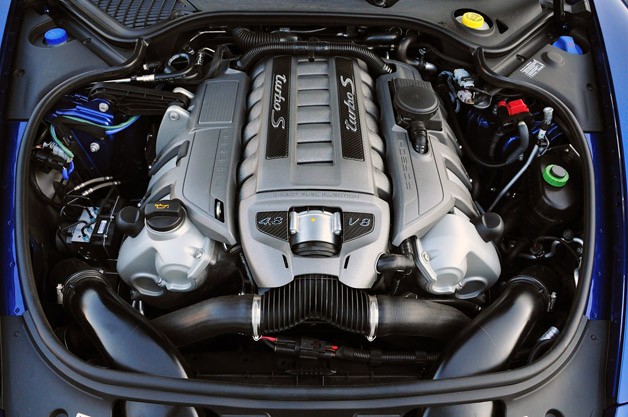
To build a Turbo S, Porsche starts with the twin-turbocharged 4.8-liter V8 found under the hood of the Panamera Turbo. The stock turbocharger impellers, made with Inconel (a trademarked type of nickel-chromium-based superalloy), are replaced with lightweight titanium-alloy turbine wheels that are half the weight for improved engine response. To give the improved turbochargers a bit more kick, the engine control is modified to allow even more intake pressure for brief periods of time (normally 12.3 psi, but up to 13.5 psi during this overboost mode). The result is a rating of 550 horsepower at 6,000 RPM and 590 pound-feet of torque from 2,500 to 4,000 RPM.The Turbo S will crack 60 mph in 3.5 seconds on its way towards a top speed of 190 mph.
It takes special hardware to handle this much power, so the engine is bolted to Porsche's seven-speed dual-clutch (PDK) automatic gearbox that sends power to all four wheels. Use launch control (a unique 'Sport Chrono Package Turbo' is standard) and the Turbo S will crack 60 mph in 3.5 seconds on its way towards a blistering top speed of 190 mph. Others are faster, but none launch as quickly out of the gate.
To improve the odds that most of the 550 horsepower will find its way to the pavement and that the driver will be able to keep the car rubber-side down, Porsche has loaded the Panamera Turbo S with innovative technology, and nearly all of it is standard. The all-wheel-drive system features Porsche Traction Management (PTM) to electronically control torque distribution to each wheel to improve grip, while Porsche Torque Vectoring Plus (or PTV Plus) electronically manages the locking rear differential with variable side-to-side torque distribution to improve handling. The standard underpinnings include a combination of an adaptive air suspension and Porsche's Active Suspension Management (PASM) adaptive damper control. There is also Porsche Dynamic Chassis Control (PDCC) to limit roll on the longitudinal axis to keep the wide tires flat against the road surface.
The standard brakes, distinguished by their red calipers, are massive six-piston aluminum monobloc up front (with 15.35-inch rotors) and four-piston aluminum monobloc calipers in the rear (with 13.78-inch rotors). Optional, and fitted to our blue test vehicle, are the telltale yellow calipers of Porsche's Ceramic Composite Brake (PCCB) system. In addition to saving unsprung weight on all four corners, the front rotors grow to a massive 16.14 inches in diameter. Standard fitment includes 20-inch wheels wearing 255/40ZR20 tires up front and 295/35ZR20 tires at the rear.Fitted to our blue test vehicle are the telltale yellow calipers of Porsche's Ceramic Composite Brake system.
But the enhancements aren't solely mechanical, as the Turbo S also features a slightly upgraded cabin with a standard 585-watt Bose audio package, bi-color leather options and a Comfort Memory package with extending seat bottoms, lumbar support and an electric steering column adjustment. Of course, there is also the obligatory badging.
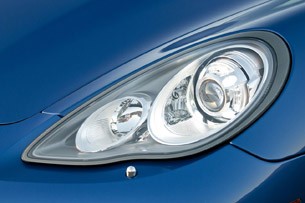
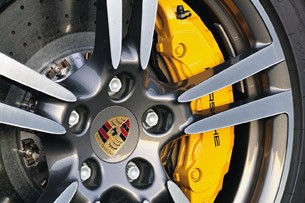
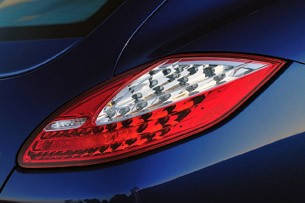
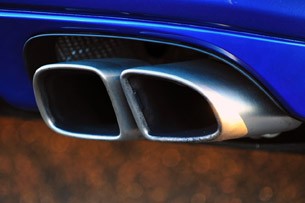
While the Panamera Turbo starts at $136,700, the Turbo S has a base price of $173,200 (yes, that's a premium of $36,500, or a brand-new Volkswagen Golf R). Above and beyond the base price, our test car was equipped with a series of options including the Aqua Blue Metallic paint ($3,140), Adaptive Sport Seats ($1,505), Porsche Ceramic Brakes ($8,840) and the Carbon Interior Package ($995). In addition, it was configured with a couple exclusive options including the SportDesign package ($4,160) and the Carbon Fiber Illuminated Door Sill Guards ($1,850). The (very) grand total, including a $975 destination charge? $194,665. Nobody said one-upping your neighbors was going to be inexpensive.The (very) grand total, including a $975 destination charge? $194,665.
Drop into the cabin without reading the scripting printed on the face of the tachometer, and most would be hard-pressed to tell the difference between a standard V6 Panamera and a Turbo S from the driver's vantage (that's a not necessarily a bad thing as the cabins at all price points are impeccably appointed). In our test car, fine leather covered just about every soft surface, while the hard panels were decorated with glossy carbon fiber and contrasting bright aluminum. The overall look was clean, but a bit cold (especially in our monochromatic gray color scheme) and initially confusing, with a sea of small buttons smattered all over the cluster and console. Then again, those same complaints may also be lodged against the cryptic cockpit of a corporate jet.
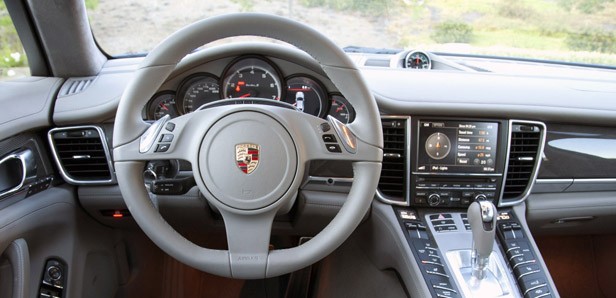
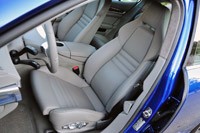
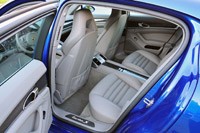
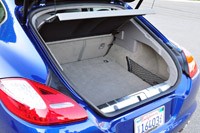
Despite having had plenty of seat time in a range of Panamera models, we were genuinely giddy about getting to drive the Turbo S. After all, who doesn't want to blast away everything but a few rare exotics while sitting comfortably behind the wheel of a four-door? Thankfully, after a week with the blue monster, it was obvious that our rose-colored dreams for the most part matched reality. We didn't meet anyone who could come even remotely close to nipping at the heels of the Turbo S, in any driving situation, despite a surprising number of people trying.An 85-year-old grandmother could drive the Turbo S every bit as pleasantly as a Toyota Camry.
As a daily driver, the Turbo S is very comfortable – as expected – and four adult passengers will find travel nothing but first class. The flagship Panamera is loaded with all of the creature comforts and driving aids currently known to man, so keeping everything in default mode upon startup will tell the adaptive suspension that the passengers prefer to be coddled rather than convulsed, and the dual-clutch PDK transmission will shift like a well-heeled gentleman. Aside from being a bit more difficult with regards to ingress/egress, an 85-year-old grandmother could drive the Turbo S every bit as pleasantly as a Toyota Camry. But that would be a complete waste of available talent.
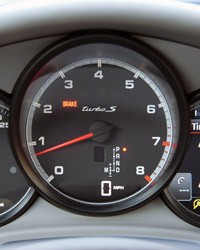
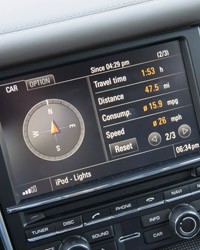
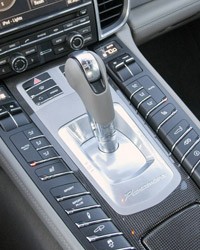
To take full advantage of the Turbo S driving experience, one has to press a few console-mounted buttons after the engine fires up. Most important is the "Sport Plus" switch, as it remaps the throttle and PDK response to a highly caffeinated level. The suspension button, just aft of the Sport Plus button, is used to firm up the dampers. Lastly, one needs to press the exhaust button on the other side of the console to release the thunder from the quad exhaust tips.
Air sickness bags are not standard equipment, but they should be. In its hyper state, the Turbo S is insanely fast and unexpectedly agile.
Smash the throttle against the floor and the hefty sedan (a not-so-dainty 4,398 pounds) catapults off the line with a trail of blowing debris in its wake. There is a hint of turbo lag, but once fully spooled, the turbochargers make easy work of acceleration, regardless of the speed. Stoplights and freeway on-ramps became non-issues, as it only took a heavy right foot to fill the rearview mirrors with shrinking headlights. Merging and passing were painless at all speeds, regardless of the passenger load or surface grip. This Porsche wants to escape.
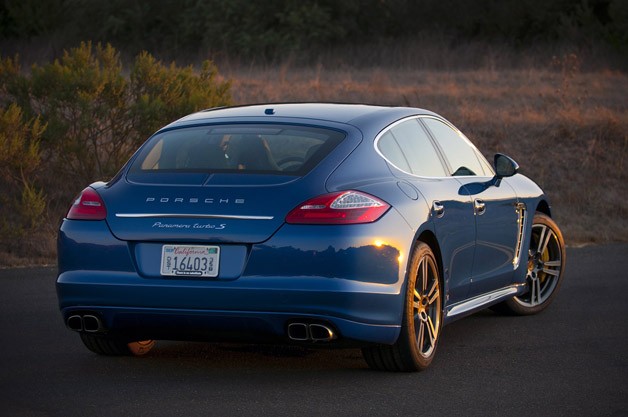
In defiance of its length, wheelbase and mass, this sedan is also implausibly athletic. Keep the seatbelt sign illuminated, and strapped passengers will stay snug in their seats as the Panamera rips it up in the canyons. All-wheel-drive grip, low-end thrust and Porsche's torque vectoring rear differential make easy work of corners. Oversized brakes, lightweight and fade-resistant ceramics on our test car, added even more confidence. When it came to performance, Porsche's Panamera Turbo S was everything we expected and more. But even as it delivered gut-wrenching acceleration and cheek-stretching grip, we couldn't help but keep thinking that the Turbo S drove just like... well, almost like a standard Turbo.
The standard Turbo gives up 50 horsepower, a few ticks in the sprint to sixty and two miles per hour in top speed to its S-badged sibling. They are both insanely quick and it would require sophisticated test equipment to tell the difference between the two models on the track. Quite frankly, on public roads, one's performance advantage over the other would be left to the driver.We couldn't help but keep thinking that the Turbo S drove just like... well, almost like a standard Turbo.
Yet a 550-horsepower range-topper like this isn't about objective reality. It is about one-upmanship.
While it would be nearly impossible for anyone to rationalize its $36,500 premium over the standard bloody-fast sedan, it is our belief that if you can afford the Turbo, you can swing the Turbo S. We surely would. After all, in its affluent arena, it is almost a necessity to ensure that you don't get trumped by your next door neighbor.










Sign in to post
Please sign in to leave a comment.
Continue